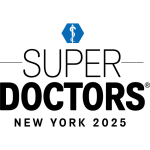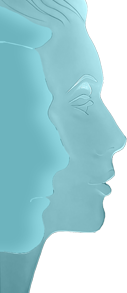

The non-surgical Liquid FaceLift procedure is one of our most popular cosmetic treatments because they deliver stunning immediate results without surgery or downtime. Dr. Bruce Robinson is proud to offer the best dermal fillers on the market to help you achieve your aesthetic goals. Injectables expert Dr. Bruce Robinson performs the procedure using cosmetic fillers to plump deep creases, minimize fine lines wrinkles & restore volume back in your face. Lifting sagging skin and restoring the natural shape of the face. The Liquid FaceLift treatment sculpts the face back to its original form while maintaining a natural look. Unlike a surgical facelift during Liquid FaceLift, there is no surgical cutting, removal, or repositioning of the tissues, and no stretching of the skin. It's you, only younger.
Did you know that many visible signs of aging can be traced back to volume loss? As facial tissues thin out, lines become etched around the nose, mouth and cheeks. Dermal fillers replace lost volume to help smooth wrinkles, diminish the appearance of dark circles under the eyes, turn up the corners of your mouth, undo the impression of unhappiness and restore a more youthful appearance.
Lip Enhancement fillers can restore volume and fullness in deflated and dehydrated lips turning "up" the corners of your mouth.
The results are immediate and natural; resulting in the WOW effect. Friends and family will comment on how well rested you look or inquire if you have changed your hair, often, without ever knowing what was done, as it truly "looks natural".
Give your skin a lift, without surgery and very little downtime. Schedule a dermal filler consultation today.
As we age, our skin inevitably loses its youthful appearance as the production of natural dermal volumisers such as hyaluronic acid (HA) diminish, leaving lines and wrinkles where our skin once was plump, youthful, and radiant. Today, the signs and symptoms of the natural ageing process can be reduced by replacing lost volume. While dermal fillers are casually known as "wrinkle fillers," they can do so much more!
How Can Dermal fillers Enhance My Appearance?
*Smooth out lines around the nose and mouth (a.k.a. marionette lines, smile lines and parentheses)
*Enhance and restore volume to cheeks, reduce the appearance of dark circles and sunken eyes
*Diminish vertical lip lines
*Plump and enhance lips
*Smooth out chin creases
*Improve symmetry among facial features. (e.g., define chin & jawline, non-surgical rhinoplasty or nose job)
What are Fillers Made With?
There are a variety of FDA approved filler products that cosmetic dermatologists use. A note for your safety, always make sure you are receiving FDA approved, brand name fillers, which are available ONLY through licensed physician's.
Which Filler Do I Need?
With so many dermal filler products on the market, it can be difficult to know which option is best for you without an experienced cosmetic dermatologist's guidance. Each product is uniquely formulated to have a certain texture, density and injection depth which means that certain fillers work better for certain areas of concern. Dr. Robinson will determine what product is best for you, the following diagram illustrates in general where board certified dermatologists tend to apply certain products:
What to Expect During Treatment
Dermal filler injections are non-surgical and typically completed during an office visit. Your initial treatment will begin with a consultation, during which you will discuss your concerns, goals and medical history with Dr. Robinson. While the risks associated with dermal fillers are minimal, you will need to fully disclose your medical history prior to treatment, as certain allergies, skin and neurological conditions or medications can jeopardize your safety or results. For instance, you need to tell you doctor if you have been taking NSAID's (e.g., aspirin, ibuprofen, naproxen) or blood thinner, as these may increase the likelihood of bruising.
You may be given a topical anesthetic to numb the area prior to injection. although many filler products also contain lidocaine, a mild anesthetic, which is intended to help minimize discomfort during and after your treatment. Your doctor will then inject a precise amount of filler strategically beneath the skin.
Depending on the product and the areas treated, you should be able to notice subtle, natural looking results immediately. Some patients experience bruising and swelling, but these are temporary and should subside over the days following treatment. You will be able to go back to your normal activities right after treatment
How Long Do The Results Last?
How long the effects of dermal filler will last depends on the product, the area treated and the individual patient. The results are not permanent making timing of when you receive your treatments essential. To maintain your results, Dr. Robinson will simply repeat treatment as needed, adjusting the amount and techniques as necessary to ensure optimal results.
Combining Botox and Filler - SWEET!
Botox and dermal fillers are very different types of injectables, however they complement each other quite nicely. When used together you can address multiple areas of the face simultaneously. Botox is typically used around the eyes and forehead, whereas dermal fillers are generally used on the middle and lower areas of the face. Using Botox and dermal fillers together can also prolong the results of treatment. In the long run you may even ending up saving money by combining the two treatments.
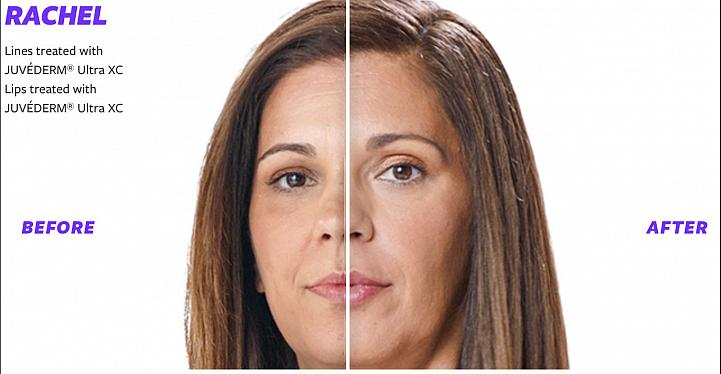
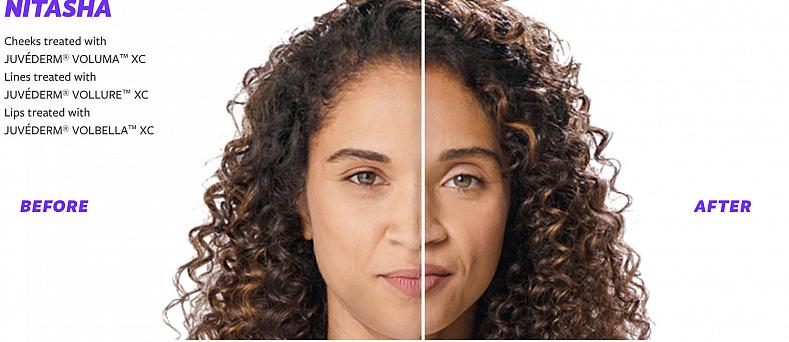
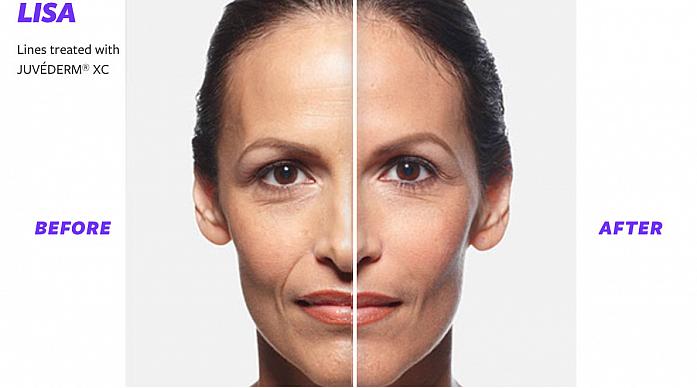
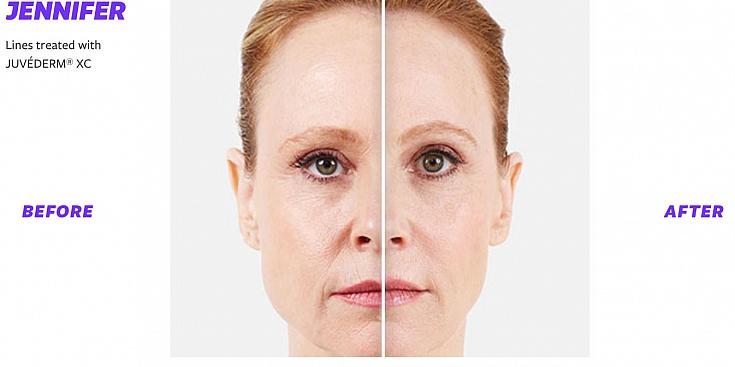
Schedule an office visit to discuss your concerns and skincare goals with Dr. Robinson and the office visit cost will be applied to the future cost for the "consulted procedure". The "consulted procedure" must be completed within 30 days of your consult visit.
Laser treatments can be an ideal alternative for treating hyperpigmentation in addition to sun damage and fine lines. There are quite a few laser treatments on the market, but we're here to share information about Erbium laser resurfacing, a treatment that does it all and treats everything from wrinkles, acne scars to sun damage and brown spots/age spots. While this treatment provides a more youthful appearance it usually requires a week of down time.
Erbium laser resurfacing uses light energy and is designed to remove the upper most superficial layers. Removing brown spots and benign and precancerous bumps/growths. The Erbium laser results in a narrower area of heating of adjacent tissues compared with other laser skin-resurfacing methods. This results in a more focused removal of old skin cell layers. And this means that a benefit of Erbium laser resurfacing is minimal burning of surrounding tissue and fewer side effects such as swelling, bruising, and redness, so the recovery time should be faster than with CO2 laser resurfacing. During the healing process new collagen is generated for a more youthful appearance.
Helps reverse sun damage
Treats fine lines, wrinkles, and hyperpigmentation
Requires no downtime
Can be safer for lighter-toned Black, Hispanic, or Asian skin tones, Erbium laser resurfacing can sometimes be a good option. Patients with darker brown skin may need to consider other skin resurfacing options, such as radio-frequency treatments.
With the use of a potent topical anesthetic the Erbium laser treatment is well tolerated. Usually up to the first hour after treatment it feels like a bad sunburn. After which it may feel sore and have some bruising and mild swelling for a few days. Followed by a few days of skin flaking for another two to three days. Usually, the total recovery/healing on average takes about 10-14 days, depending on the problem and area that was treated.
Despite the downtime, the benefits are that you require fewer laser treatments to obtain your goal of smoother, younger looking skin.
If you're ready to treat skin concerns that your skincare routine cannot address, talk with Dr. Bruce Robinson about Erbium laser resurfacing.
Torn, split or long and droopy earlobe rejuvenation is an easy in-office procedure that takes approximately 30 minutes from start to finish. Under local anesthesia an enlarged earring hole is closed or a torn earlobe is restored. The sutures are removed in just one week. Dr. Robinson can re-pierce your ears 6 weeks later (https://brucerobinsonmd.com/earlobe-piercing/). So go ahead and get those earrings you always wanted but couldn't wear.
Yes! While a torn earlobe can be painful and distressing, an expert dermatologist like Dr. Bruce Robinson can effectively repair it with just a few precise sutures. Using advanced cosmetic surgical techniques, Dr. Robinson ensures a clean repair that typically heals into a small, barely noticeable scar. About three months after the procedure, patients can return for professional re-piercing. Dr. Robinson carefully places the new piercing at a safe distance from the repaired area to prevent any further damage.
The first step in repairing a torn earlobe is a consultation with experienced, board-certified dermatologist Dr. Bruce Robinson. He will thoroughly evaluate the damage and determine if you’re a good candidate for earlobe repair. Listening closely to your cosmetic goals, Dr. Robinson will develop a personalized treatment plan tailored to your needs.
The procedure is performed safely in-office without sedation or general anesthesia. Dr. Robinson will numb the earlobe with local anesthesia to ensure your comfort throughout the treatment. He will then carefully remove any scar tissue around the tear and expertly suture the wound closed. The exact technique used depends on the severity of the tear, whether it’s a minor split or a complete rupture. For patients with sagging earlobes, Dr. Robinson may also use hyaluronic acid fillers like Juvederm or Restylane to restore volume and lift.
After the procedure, Dr. Robinson will provide detailed post-care instructions. Most patients only need over-the-counter pain relief, such as Tylenol, if any discomfort arises. Sutures are typically removed two weeks post-treatment, and approximately three months later, patients can return for safe and precise earlobe re-piercing. Dr. Robinson ensures the new piercings are symmetrical and positioned to avoid further damage to the repaired area.
Sagging or stretched earlobes can result from various factors. Tears or injuries, frequent wearing of heavy earrings, and even sleeping with earrings can stretch the delicate skin, causing earlobes to sag over time. Additionally, natural aging reduces collagen and elastin production, proteins essential for skin firmness and elasticity leading to loss of volume and drooping earlobes.
Dr. Robinson offers a non-surgical solution to restore lost volume and firmness using dermal fillers like Restylane and Juvederm. These fillers contain hyaluronic acid, a naturally occurring substance that enhances skin hydration and volume. Injecting these fillers into the earlobes improves elasticity and helps support earrings comfortably.
The earlobe filler treatment is quick, simple, and minimally uncomfortable. A topical numbing cream is applied about an hour before your appointment to reduce any discomfort. Once in the office, the area is cleaned and sterilized before Dr. Robinson expertly injects the chosen filler to rejuvenate your earlobes. After the procedure, ice is applied to minimize swelling or bruising.
Mild redness, swelling, or bruising may occur but typically resolve within a few days. To reduce bruising, patients prone to it can take oral Arnica supplements before and after treatment. It’s also recommended to avoid blood thinners such as NSAIDs, fish oil, and vitamin E for one week before and after the procedure.
Dermal fillers provide a safe and effective, non-invasive way to restore volume and durability to sagging earlobes. Results usually last about six months, depending on the filler used.
Schedule an office visit to discuss your concerns and skincare goals with Dr. Robinson and the office visit cost will be applied to the future cost for the "consulted procedure". The "consulted procedure" must be completed within 30 days of your consult visit.
The Coren PS earpiercer painlessly pierces your earlobes and inserts a sterile, hypoallergenic, 24k gold ear stud.
You laugh, you frown, you concentrate... and over time, those expressions leave their mark upon you face. No one is immune to wrinkles. Just squinting in the bright sunlight or concentrating at a board meeting can create facial lines over time. Reveal a younger looking you by erasing fine lines and wrinkles while maintaining your ability to make natural facial expressions.
Dysport, a muscle relaxer, targets "expression" lines and wrinkles. Over time “dynamic wrinkles” created by muscle movement leave their mark on your face. Dysport injections temporarily relax the facial muscles that contribute to wrinkles every time they contract.
Dysport uses:
One ten-minute treatment – a few tiny injections – relaxes the muscles in your face that cause lines to form. There is minimal discomfort, many patients describe the injections as a pinprick or bug-bite sensation.
Within two weeks of treatment, targeted wrinkles begin to fade leaving skin looking more smooth and youthful. Improvements usually last between 3 to 6 months and can often be maintained with periodic touch-up treatments.
These quick, simple injections can effectively improve your facial wrinkles while maintaining your ability to make natural facial expressions, an essential part of what keeps you looking like you!
Men and women alike share a common desire to have healthy, youthful skin. Exposure to the sun and the elements in combination with adverse living habits contribute to the appearance of our skin. Chemical Peels are increasingly popular with those who are unhappy about acne scarring, sun-damaged skin, age spots, freckles, fine lines, rough skin and uneven pigmentation. A chemical peel is not limited to the face, and can be performed on the neck, chest, hands, arms, shoulders and leg with little or no downtime.
"All my life I had freckles on my face. Having a Chemical Peel changed that! Now my skin is smooth and clear!"
Chemical Peels are topically applied acids that aid in the restoration and rejuvenation of the skin's surface. They usually create an invisible uniform and controlled shedding of several layers of the skin. Depending on the nature and depth of the peel, a significant number of layers can be exfoliated allowing new growth to be exposed, creating a fresh vibrant appearance.
Your skin type and the results you are aspiring to achieve will determine if you are a candidate, as well as which class of peel is most appropriate for you.
Chemical peels can enhance your appearance by reducing blotchy and uneven pigmentation, fine lines and wrinkles, freckling, age spots, sun-damaged skin, and acne scars in a relatively brief measure of time. Chemical peels accelerate the production of new cells. Enjoy fresh smooth skin immediately after your first treatment.
Chemical peels have become increasingly popular because of the array of advantages and relative lack of complications, Side effects are rare and usually temporary. Some side effects include uneven pigmentation, redness, and very infrequent scarring if the skin is not cared for appropriately. Sun protection is crucial to minimize the risk of side effects. A treatment program of individually suited products and sun protection will benefit your skin's ability to maintain the results of the peel. You can decrease the likelihood of side effects by carefully following your post peel instructions.
Chemical peels are classified as superficial, medium, and deep peels.
This peel is designed to help smoothen coarse, dry skin, improve the texture of sun-damaged skin, and even out skin tone. The recovery is generally rapid and usually involves some minor flaking. A series of treatments is ordinarily recommended to obtain the desired result over a period of time. Typically, there is no down time and with appropriate sun protection, you can resume regular activities immediately.
Medium peels contain a stronger potency of acids. Medium peels target the epidermis and upper dermis and cause the skin to slough within 5 - 7 days. Immediately after treatment the skin has a red appearance and is occasionally accompanied by swelling. Within a day the skin turns brown in color and after 3 or 4 days the skin initiates the peeling process.
Deep peels produce the most dramatic results. This peel is recommended for treating wrinkles, scars, blemishes and, in some cases, precancerous skin lesions. A deep peel targets the dermis. In some cases, anesthesia is required during the procedure to reduce the warm to hot stinging sensation. After a deep peel, the skin is red and can result in some swelling and blistering. A crust may form and the skin will turn brown just prior to peeling. Many layers of the skin will peel over a period of one to two weeks. An ointment may be given to keep the area moist. Temporarily, the new skin will have the color and sensation of significant sunburn, which will gradually fade to your normal skin color.
Skin Tags are growths that occur mainly in the folds of the skin such as the neck, underarms, groin, and beneath the breasts. Routinely found in families -- a father, mother or grandparent -- skin tags become more numerous with age. These growths, also referred to as barnacles, can easily be removed with an excellent and immediate cosmetic result.
If you are bothered by the moles or skin tags that occur on the neck, face, groin or under the arms or breasts then snip removal is an easy way to rid yourself of those annoying growths. It is often performed without anesthesia or pain and with a quick snip the excess skin is removed.
Psoriasis is a common, chronic, long term, relapsing skin condition where the skin cells are made to quickly often resulting in itchy silvery scaling patches that causes a rash, most commonly on the knees, elbows, trunk and scalp. It can be painful, interfere with sleep and make it hard to concentrate. The condition tends to go through cycles, flaring for a few weeks or months, then subsiding for a while.
Common signs and symptoms of psoriasis include:
There are several types of psoriasis, each of which varies in its signs and symptoms:
Many people who are predisposed to psoriasis may be free of symptoms for years until the disease is triggered by some environmental factor. Common psoriasis triggers include:
Anyone can develop psoriasis. About a third of instances begin in childhood. These factors can increase the risk of developing the disease:
If you have psoriasis, you're at greater risk of developing other conditions, including:
If you suspect that you may have psoriasis, see your health care provider. Also seek medical care if your condition:
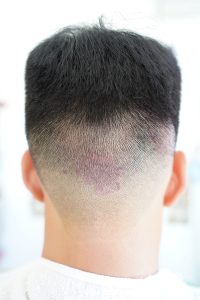
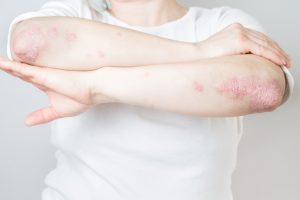
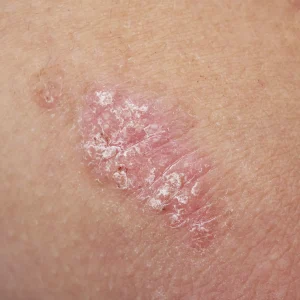
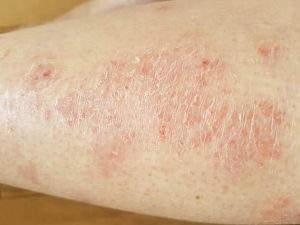
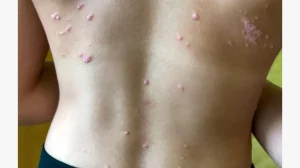
Dr. Robinson offers GentleLase and GentleYag hair removal options. The GentleLase Laser is the gold standard for hair removal in caucasians. The GentleYag laser is the gold standard for laser hair removal in patients of color or tanned skin and is also an excellent treatment for facial, leg, spider veins and hemangiomas. Laser Hair Removal can be treated in a lunch hour appointment. Hair removal can be treated every four weeks, and a typical six sessions treatment plan could be completed by June or earlier if the whole six sessions are not required
These treaments also provide excellent results in the removal of brown spots such as sun spots (liver spots) and flat benign brown keratoses. Candela's (the makers of the GentleLase) patented Dynamic Cooling Device (DCD) technology protects the upper layers of your skin with a cooling mist. Together, the long-pulse laser and DCD cooling offer optimal treatment with minimal side effects.
Depending on the amount of hair being treated, the procedure varies from patient to patient. Generally, the treatment will include:
For Women:
For Men:
Hair grows in cycles. The number of treatments required depends upon your skin color, hair color and coarseness of hair and location of treatment. Everyone will require at least 2-3 treatments, as the process is only effective on hair during the early growing cycle. Repeat sessions will be necessary to treat these follicles when they re-enter the early growth phase.
The laser creates a beam of high-intensity light that penetrates deeply into skin tissue, where it delivers a controlled amount of therapeutic heat to the targeted hair or spider veins. Canadela's patented Dynamic Cooling Device (DCD) technology protects the upper layers of your skin with a cooling burst of cryogen. Together, the long-pulse laser and DCD cooling offer optimal treatment with minimal side effects.
Treatment will take place in Dr. Bruce Robinson's New York office. You will wear safety eyewear to protect your eyes from the laser light. Dr. Bruce Robinson will guide the laser to the treatment areas with a small handpiece. Each laser pulse may be preceded and followed by a short pulse of cooling spray. A treatment could take as little as a few minutes to as long as an hour, depending on the area being treated.
Some patients may feel a slight discomfort with each laser pulse, sometimes described as the snapping of a rubber band on the skin. This discomfort resolves in several seconds and is minimized by Candela's DCD cooling. For some patients, a topical anesthetic may be used prior to treatment. Be sure to discuss this with Dr. Bruce Robinson before the procedure if applicable.
The number of sessions depends on the treatment you require and the condition of your skin. Multiple treatments may be required, but many factors impact the efficacy of individual laser treatments, including the severity of the condition being treated.
Your skin should be thoroughly cleaned and dried, removing any makeup, creams, oils, topical anesthetics or self-tanning products before laser treatment. If you have had a history of herpes simplex virus and are scheduled for facial vain or hair removal treatment, prophylactic antiviral therapy may be prescribed. The intended treatment area should not be exposed to sunlight or tanning booth light for 14 days prior to treatment.
A cool compress or gel pack may be applied for comfort following your treatment. If any redness or swelling should occur it resolves within a few hours.
After laser treatment, prevent sun exposure by applying sunblock (SPF 30 or above). In the first few days after treatment, don't scrub or rinse the treated areas with abrasive skin cleansers. Dr. Bruce Robinson may advise additional precautions.
Your risks are minimal. Although rare, effects may include redness, swelling, hyperpigmentation, hypopigmentation, blistering and purpura (a laser bruise) in the treated area--these usually do not last more than a few hours to a few days. Permanent side effects are rare. Be sure to discuss potential side effects with Dr. Bruce Robinson.
Most insurance companies do not offer reimbursement for cosmetic procedures. We offer a Cosmetic Consultation Reimbursement policy offered to all our patients. Come discuss your needs and goals with Dr. Robinson and the office visit cost will be applied to future costs for the discussed procedure. *Procedure must be completed within 30 days of your consult visit.
SculpSure® Transform your body in a series of 25 minute treatments. Non-surgical body contouring is a laser treatment that safely and permanently destroys up to 24% of stubborn fat cells per treatment that has resisted traditional diet and exercise. SculpSure® is a non-invasive treatment that targets stubborn problem areas such as the belly, love handles, back, and inner and outer thighs. There is no downtime so you can swim, spin, and get right back to the gym. Results are often seen as soon as six weeks after treatment.
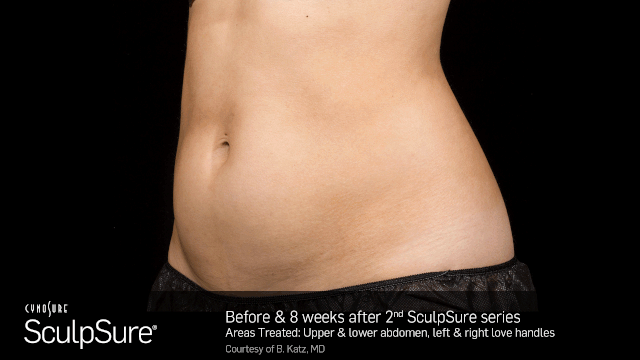 | 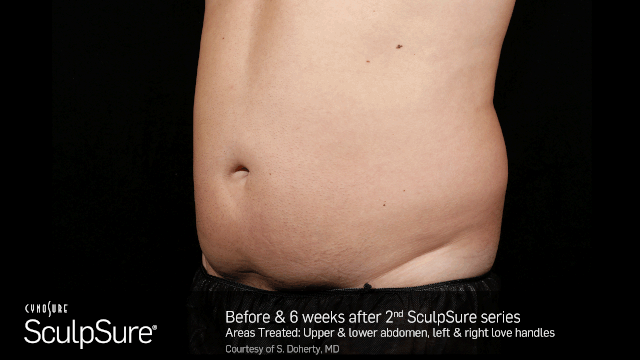 |
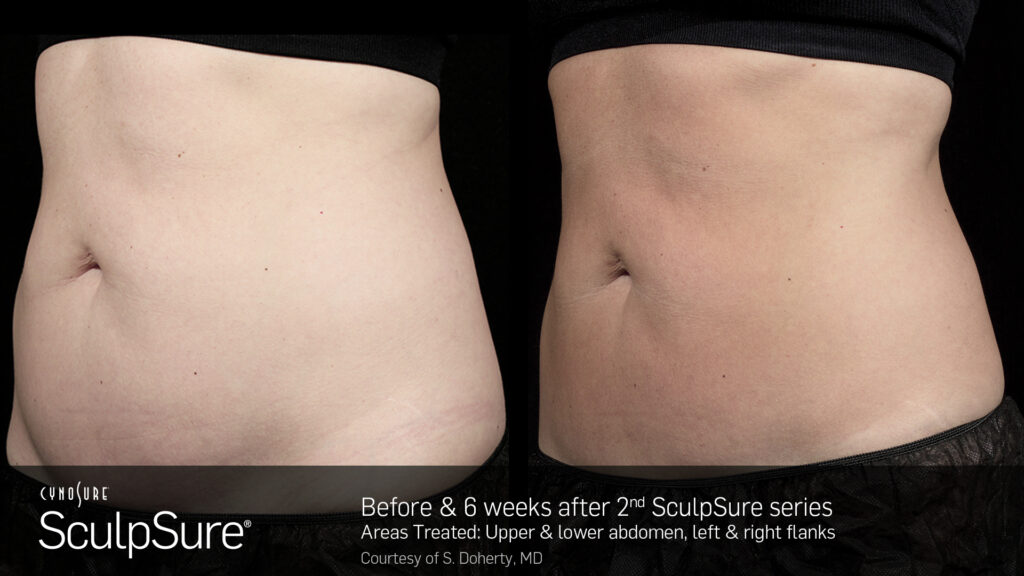
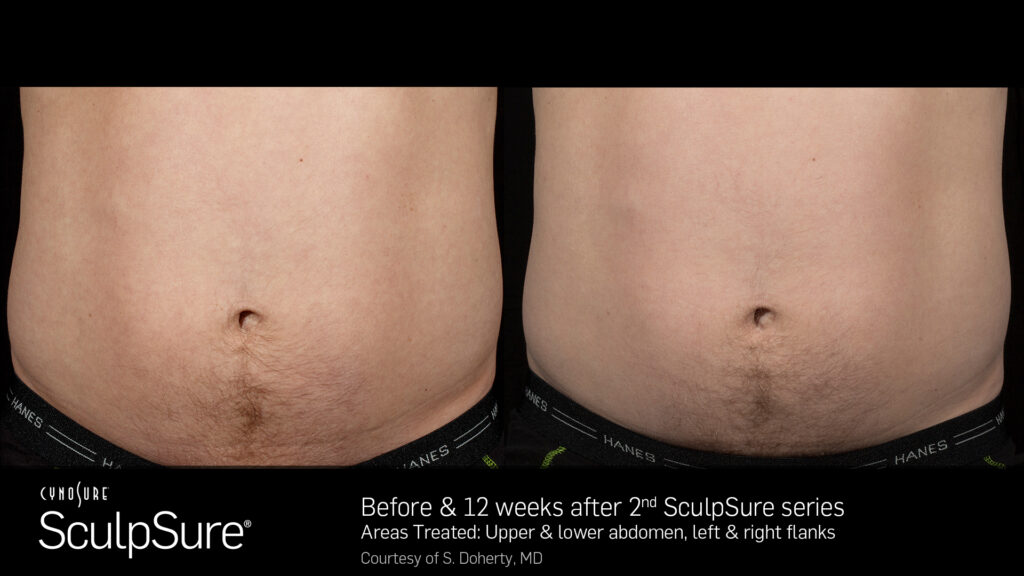

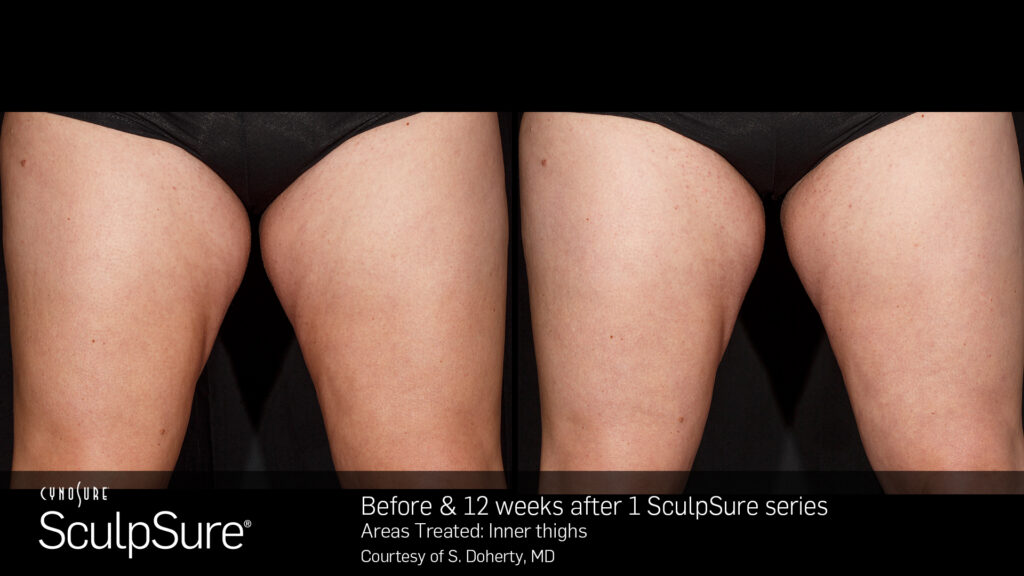
SculpSure® :
Treatments take just 25 minutes per treatment area
Treatments are customized for a variety of shapes and sizes
Contact Cooling Technology keeps the skin comfortable during the treatment.
Side effects are mild and temperary in nature, with the most common being tenderness.
The feathering of heat provides a natural - looking result.
Clinical studies have shown 83% to 100% patient satisfaction rate.
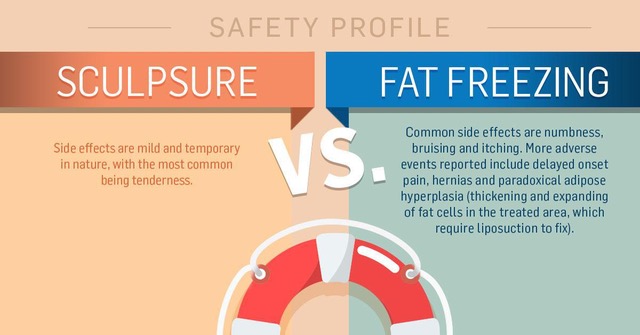
Every patient is different. Most patients see the best results when they have a series of treatments.
Most patients feel a tingling, warming, sensation intermittently throughout the treatment which is generally well tolerated. Breathe away pain and anxiety with PRO-NOX, Nitrous Oxide, relief is now in your control, empowering you to safely control your pain relief during in-office procedure(s) such as SculpSure®.
There is no recovery period or downtime with SculpSure®, you can have the during during your lunch hour, have the treatment and spin, swim or get right back to the gym immediately.
Patients may start to see results as early as 6 weeks following treatment as the body begins to gradually lose the targeted fat cells, with optimal results typically seen at 12 weeks.
Treated fat cells are permanently destroyed and will not regenerate.
What is the Difference Between Fat Loss and Weight Loss?
The number of fat cells in our bodies typically remain constant throughout our adult life. After the SculpSure treatment, the destroyed of fat cells will never return. However, as we lose weight, the size of the fat cells beome smaller, but typically do not decrease in number. Even with diet and excercise, many people have difficulty losing weight in these trouble areas.
View Dr. Robinson discuss SculpSure and treat a patient
